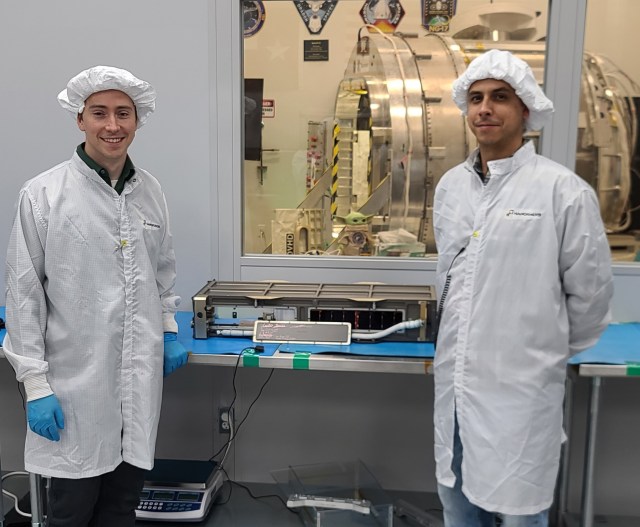The Marshall Star for March 20, 2024
Marshall Technologist Talks Solar Sail Technology in Rocket Center Exhibit By Jessica Barnett Space enthusiasts at the U.S. Space & Rocket Center were treated to a special exhibit featuring technologist Les Johnson of NASA’s Marshall Space Flight Center and a look at the future of solar sail technology. Johnson shared the latest updates on the […]
The Marshall Star for March 20, 2024
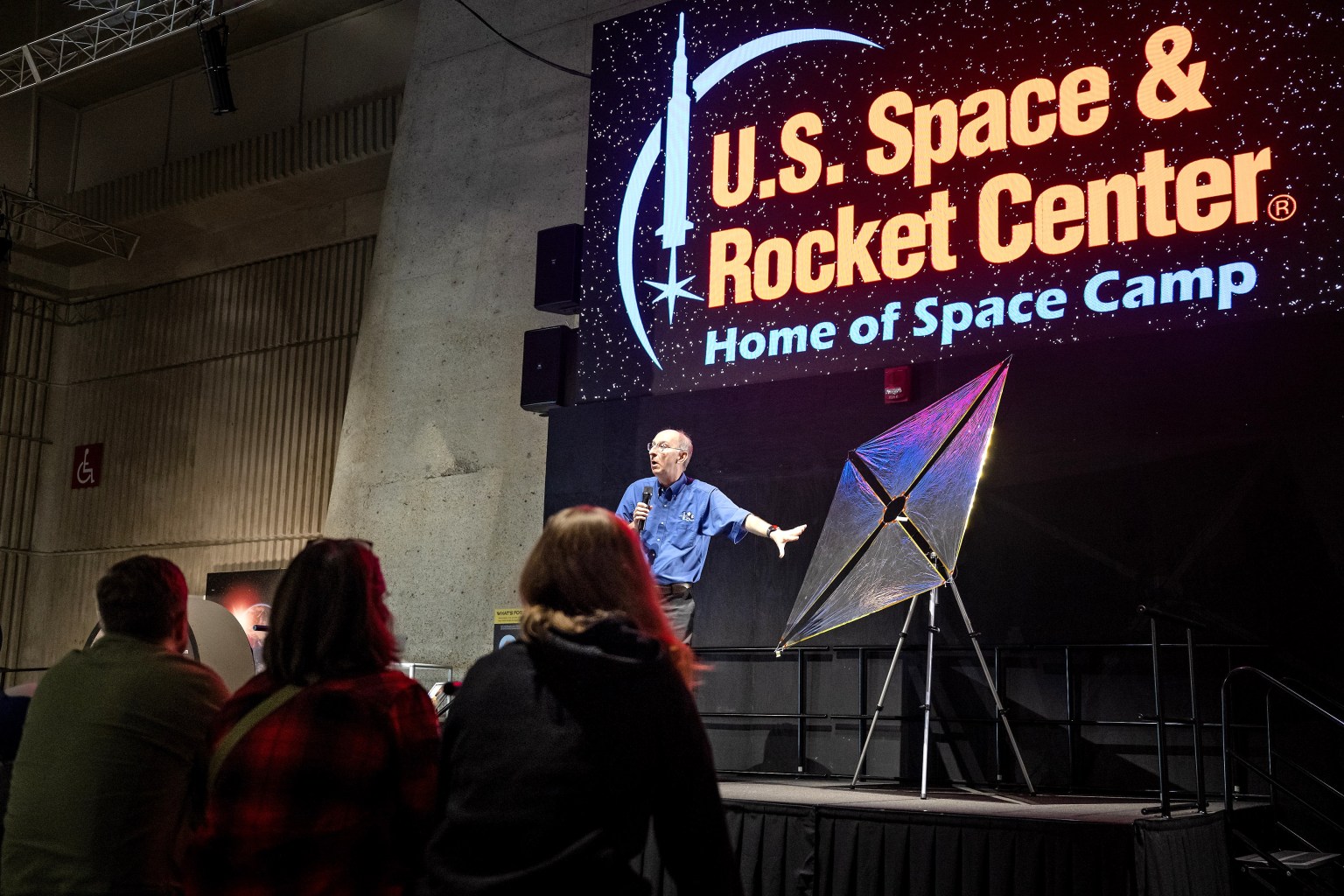
Marshall Technologist Talks Solar Sail Technology in Rocket Center Exhibit
By Jessica Barnett
Space enthusiasts at the U.S. Space & Rocket Center were treated to a special exhibit featuring technologist Les Johnson of NASA’s Marshall Space Flight Center and a look at the future of solar sail technology.
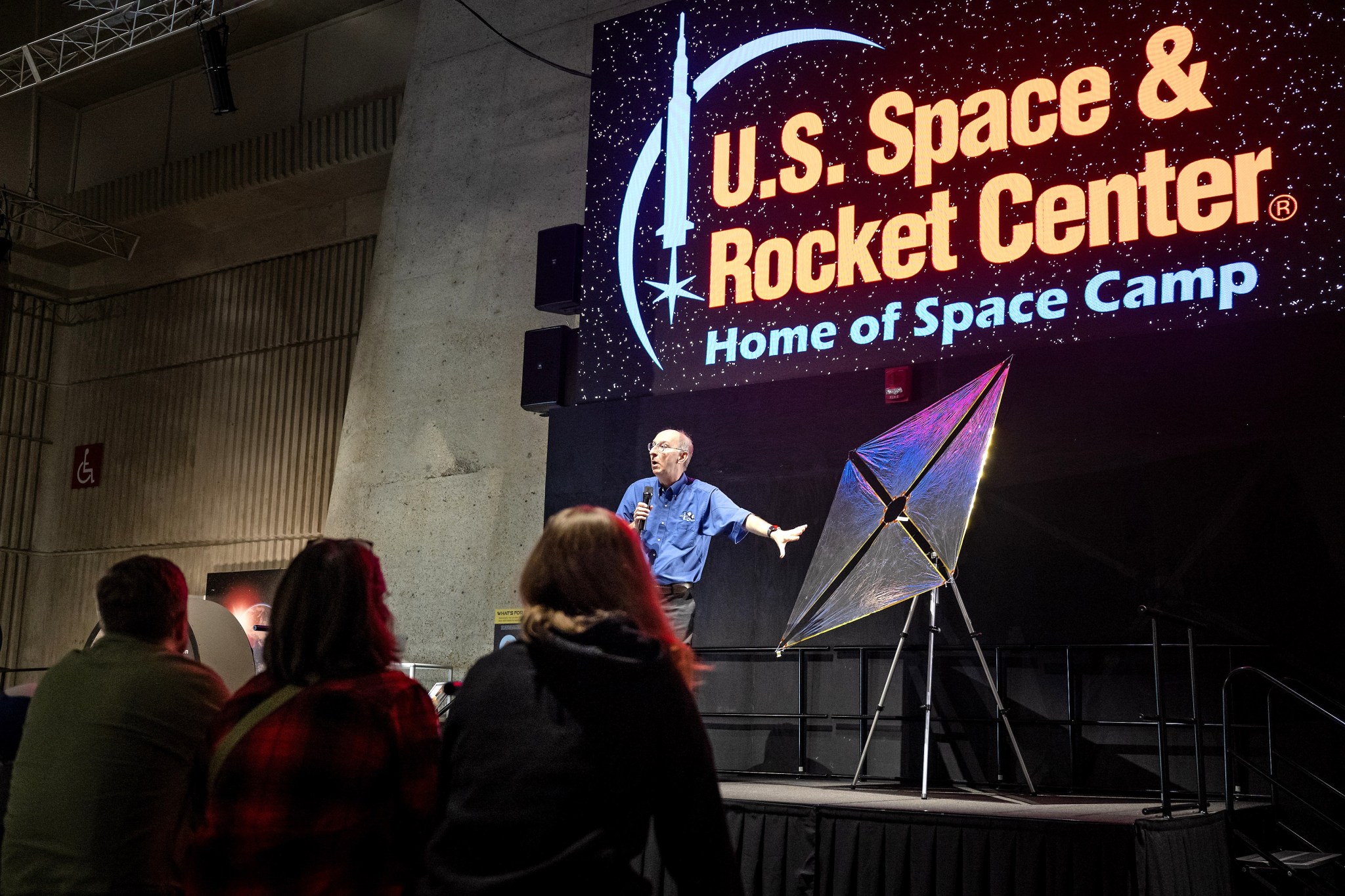
Johnson shared the latest updates on the solar sail technology through brief presentations onstage in the Rocket Center’s atrium as well as one-on-one interactions with museum guests at the various displays set up near the stage. He discussed how the technology will work, showed a video of the solar sail team testing one of the sail’s four quadrants, and discussed what it could mean for the future of space exploration.
“I’m excited about this type of propulsion, because it’s free, it doesn’t run out of fuel, and you can use it to do amazing things in the future,” Johnson said. “We could build really big sails – 10 to 100 times bigger than the Solar Cruiser sail – and instead of using sunlight, we could shine lasers on it and go out in the solar system, literally where we’ve never been before.”
NASA continues to unfurl plans for solar sail technology as a promising method of deep space transportation. The agency cleared a key technology milestone in January with one of four identical solar sail quadrants successfully deploying. Together, the solar sail quadrants will make up the 17,800-square-foot sail.
Marshall leads the solar sail team, which includes Florida-based Redwire Corporation as prime contractor and Huntsville-based NeXolve as subcontractor.
Barnett, a Media Fusion employee, supports the Marshall Office of Communications.
Robert Champion Named Manager of SLS Exploration Upper Stage Office at Marshall
Robert Champion has been named as manager of the SLS (Space Launch System) Exploration Upper Stage Office at NASA’s Marshall Space Flight Center, effective March 24th.
In his role, he will be responsible for the continued development of the exploration upper stage on the more powerful SLS Block 1B rocket, which is set to debut for the Artemis IV mission. Marshall manages the SLS Program.
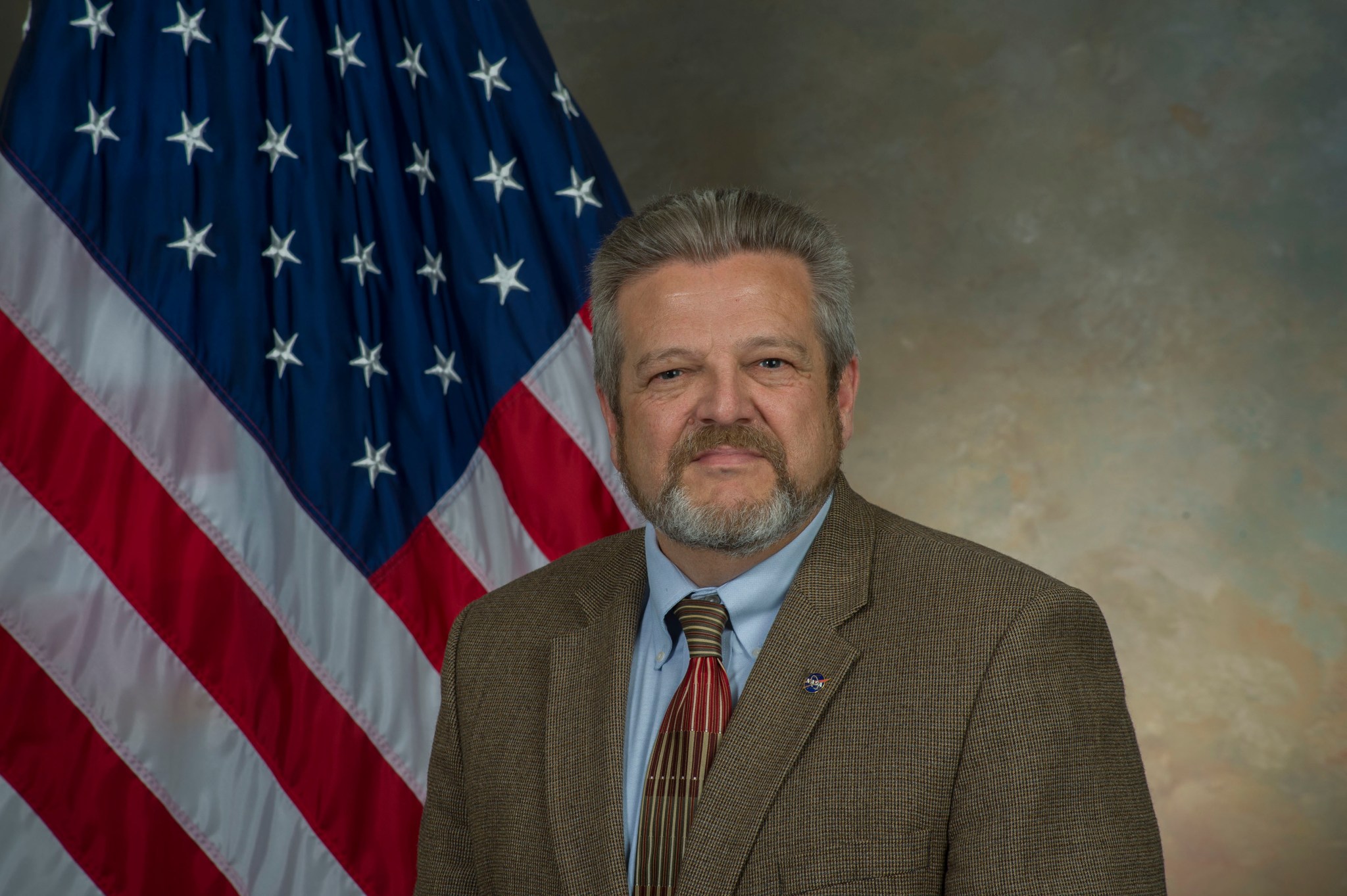
Champion has been director of the Office of Center Operations at Marshall since 2021. In that role, he managed center services that included industrial labor relations, environmental engineering, occupational health, facility management, logistics and transportation, protective services, emergency management, and subordinate site operations.
Champion previously served as the director of NASA’s Michoud Assembly Facility in New Orleans from 2019 to 2021; deputy director of Marshall’s Propulsion Systems Department from 2015 to 2019; deputy director of Marshall’s Space Systems Department from 2014 to 2015; and deputy director at Michoud from 2010 to 2014.
His 37-year career at NASA has included leadership roles in engineering, program and project organizations focused on launch vehicle development, system engineering, and propulsion systems.
Champion has received several of NASA’s highest awards, including the Presidential Rank Award, the Exceptional Achievement Medal, the Medal for Exceptional Service, Space Flight Awareness Honoree, Director’s Commendation, and the Contracting Officers Technical Representative of the Year. He was selected as an American Institute of Aeronautics and Astronautics Associate fellow and received the organization’s 2018-2019 Holger Toftoy Award for outstanding technical management in the fields of aeronautics and astronautics.
A native of Woodstock, Alabama, Champion holds a bachelor’s degree in aerospace engineering from Auburn University. He lives in Hazel Green with his wife, Maria Shelby. Combined, they have six adult children and six grandchildren.
June Malone Named Director of the Office of Center Operations at Marshall
June Malone has been named as director of the Office of Center Operations at NASA’s Marshall Space Flight Center, effective March 24.
With an annual budget of approximately $94 million, the organization includes 120 engineers and specialized civil servants and more than 500 contractors. Services provided by Center Operations include industrial labor relations, environmental engineering, occupational health, facility management, logistics and transportation, protective services, emergency management, and subordinate site operations.

Malone has been director of the Office of Strategic Analysis & Communications at Marshall since 2021. In that role, she led the organization in providing strategic planning, objective analysis, and comprehensive communication to support the policy, program, and budget decisions for the center.
Malone has worked in a variety of leadership roles throughout her 30-year NASA career. She previously was manager for Marshall’s Office of Communications from 2019 to 2021, overseeing the center’s full communications portfolio, including media, social media, website content, exhibits, history, and employee communications. Previously in 2019, she worked in Marshall’s Office of Human Capital, where she established a new Human Resources Business Partner organization and operating model. She also held a year-long position in 2016-2017 as deputy director of the Office of Strategic Analysis & Communications.
From 2014-2016 and again 2017-2019, Malone was manager of Marshall’s Office of Communication, guiding media and social media for all center projects, programs, and activities, including crisis and risk communication. She has managed public affairs and media relations activities for the Space Shuttle Propulsion Projects Office, the Space Launch Initiative, the Advanced Space Transportation Program, and the full suite of science and engineering work at Marshall. She was the primary NASA spokesperson for the Space Shuttle Propulsion Projects Office, communicating with media and the public on technical subjects and controversial issues that included the Columbia accident and Return to Flight.
Prior to joining NASA in 1991, Malone was an active-duty Air Force officer from 1985-1991. She worked at the Pentagon on the secretary of the Air Force staff in the Office of Public Affairs as a public affairs officer, and subsequently at Tactical Air Command at Langley Air Force Base in Hampton, Virginia, during Operation Desert Storm. She formulated and implemented public affairs and media relations policy, strategic public affairs activities, and media relations plans.
Malone holds a bachelor’s degree in communications from Southern Illinois University and a master’s degree in communications research from The Florida State University in Tallahassee. Her awards include a Silver Snoopy, NASA Outstanding Leadership Medal, Air Force Meritorious Service Medal, and Rotary National Award for Communication.
An Illinois native, Malone and her husband, Roy, reside in Huntsville. Their son, Wil, is a NASA engineer, and their daughter, Madison, is a medical doctor in San Francisco.
NASA Lights ‘Beacon’ on Moon with Autonomous Navigation System Test
By Rick Smith
For 30 total minutes in February, NASA lit a beacon on the Moon – successfully testing a sophisticated positioning system that will make it safer for Artemis-era explorers to visit and establish a permanent human presence on the lunar surface.
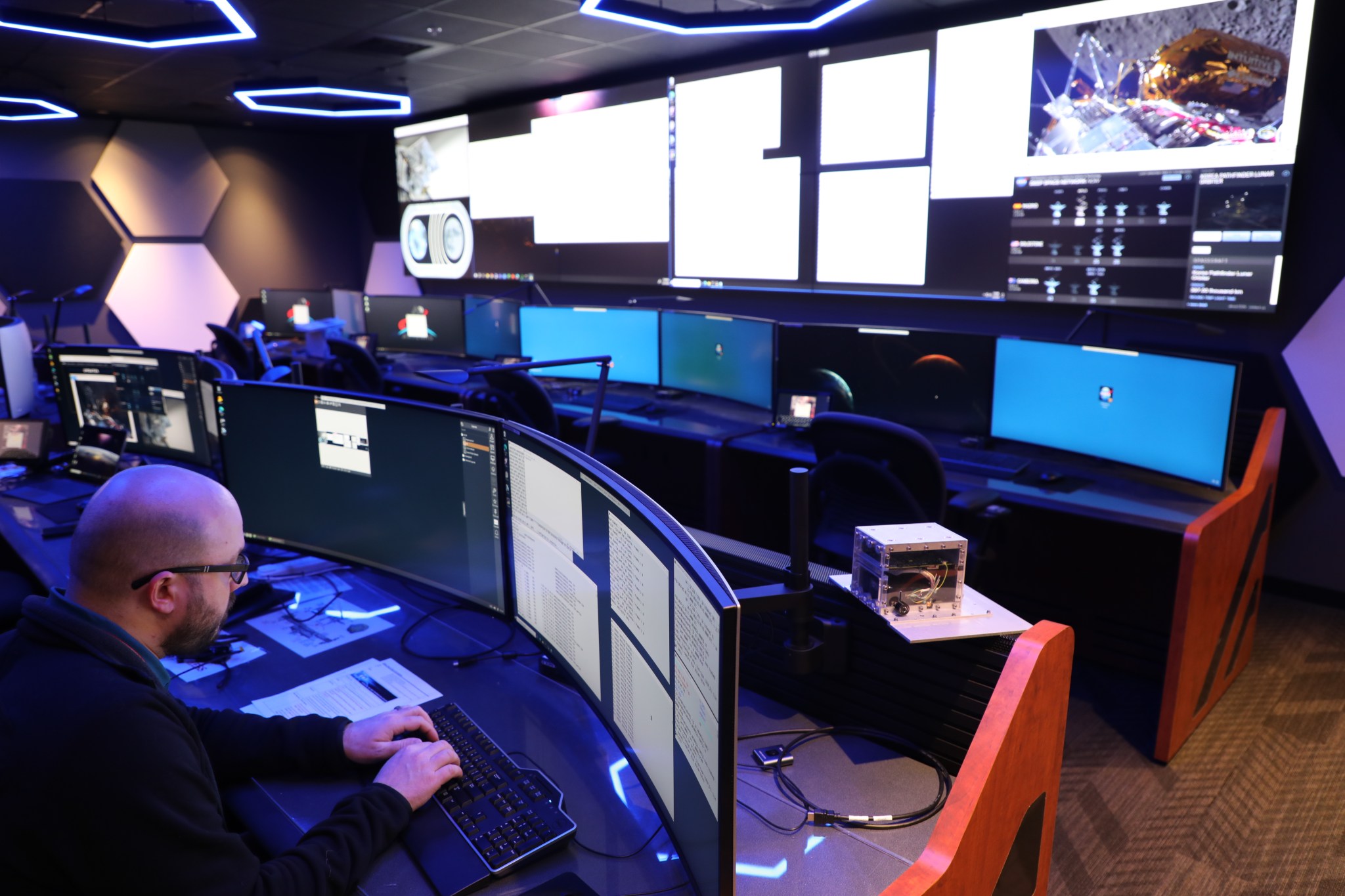
The Lunar Node 1 demonstrator, or LN-1, is an autonomous navigation system intended to provide a real-time, point-to-point communications network on the Moon. The system – tested during Intuitive Machines’ IM-1 mission as part of NASA’s CLPS (Commercial Lunar Payload Services) initiative – could link orbiters, landers, and even individual astronauts on the surface, digitally verifying each explorer’s position relative to other networked spacecraft, ground stations, or rovers on the move.
That system would be a marked improvement over conventional, Earth-based radio data relays, NASA researchers said – even more so compared to Apollo-era astronauts trying to “eyeball” distance and direction on the vast, mostly grey lunar surface.
“We’ve lit a temporary beacon on the lunar shore,” said Evan Anzalone, LN-1 principal investigator at NASA’s Marshall Space Flight Center. “Now, we seek to deliver a sustainable local network – a series of lighthouses that point the way for spacecraft and ground crews to safely, confidently spread out and explore.”
The experiment was launched Feb. 15 as a payload on the IM-1 mission. The Nova-C lander, named Odysseus, successfully touched down Feb. 22 near Malapert A, a lunar impact crater near the Moon’s South Pole region, executing the first American commercial uncrewed landing on the Moon. The lander spent its subsequent days on the surface conducting six science and technology demonstrations, among them LN-1, before it officially powered down on Feb. 29.
“This feat from Intuitive Machines, SpaceX, and NASA demonstrates the promise of American leadership in space and the power of commercial partnerships under NASA’s CLPS initiative,” NASA Administrator Bill Nelson said in a statement after the landing. “Further, this success opens the door for new voyages under Artemis to send astronauts to the Moon, then on to Mars.”
During IM-1’s translunar journey, the Marshall team conducted daily tests of the LN-1 beacon. The original plan was for the payload to transmit its beacon around the clock upon landing. NASA’s Deep Space Network, the international giant radio antenna array, would have received that signal for, on average, 10 hours daily.
Instead, due to the lander’s touchdown orientation, LN-1 conducted two 15-minute transmissions from the surface. DSN assets successfully locked on the signal, feeding telemetry, navigation measurements, and other data to researchers at Marshall, NASA’s Jet Propulsion Laboratory, and Morehead State University in Morehead, Kentucky. The team continues to evaluate the data.
LN-1 even provided critical backup to IM-1’s onboard navigation system, noted Dr. Susan Lederer, CLPS project scientist at NASA’s Johnson Space Center. The LN-1 team “really stepped up to the task,” she said, by relaying spacecraft positioning data during translunar flight to NASA’s Deep Space Network satellites at the Goldstone and Madrid Deep Space Communications Complexes in Fort Irwin, California, and Robledo de Chavela, Spain, respectively.
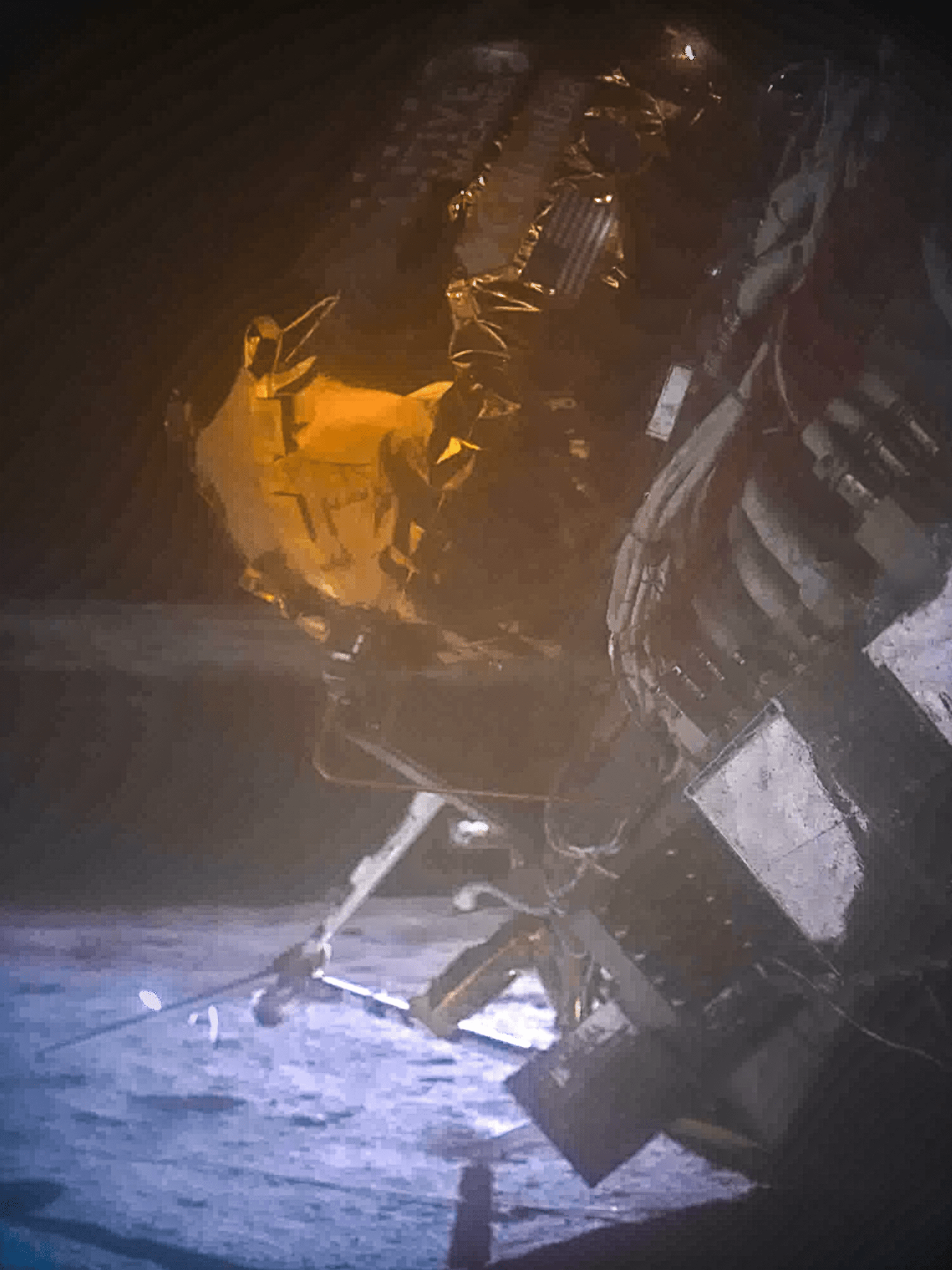
In time, navigation aids such as Lunar Node-1 could be used to augment navigation and communication relays and surface nodes, providing increased robustness and capability to a variety of users in orbit and on the surface.
As the lunar infrastructure expands, Anzalone envisions LN-1 evolving into something akin to a network that monitors and maintains a busy metropolitan subway system, tracking every “train” in real time, and operating as one part of a larger, LunaNet-compatible architecture, augmenting other NASA and international investments, including the Japanese Aerospace Exploration Agency’s Lunar Navigation Satellite System.
And the technology promises even greater value to NASA’s Moon to Mars efforts, he said. LN-1 may improve data delivery to lunar explorers by just a matter of seconds over conventional relays – but real-time navigation and positioning becomes much more vital on Mars, where transmission delays from Earth can take up to 20 minutes.
“That’s a very long time to wait for a spacecraft pilot making a precision orbital adjustment, or humans traversing uncharted Martian landscapes,” Anzalone said. “LN-1 can make lighthouse beacons of every explorer, vehicle, temporary or long-term camp, and site of interest we send to the Moon and to Mars.”
Marshall engineers designed, developed, integrated, and tested LN-1 as part of the NPLP (NASA-Provided Lunar Payloads) project funded by the agency’s Science Mission Directorate. Marshall also developed MAPS (Multi-spacecraft Autonomous Positioning System), the underlying networked computer navigation software. MAPS previously was tested on the International Space Station in 2018, using NASA’s Space Communications and Navigations (SCaN) Testbed.
NASA’s CLPS initiative oversees industry development, testing, and launch of small robotic landers and rovers supporting NASA’s Artemis campaign. Learn more here.
Smith, an Aeyon/MTS employee, supports the Marshall Office of Communications.
NASA Artemis Mission Progresses with SpaceX Starship Test Flight
As part of NASA’s Artemis campaign to return humans to the Moon for the benefit of all, the agency is working with SpaceX to develop the company’s Starship human landing system (HLS), which will land astronauts near the Moon’s South Pole during the Artemis III and Artemis IV missions. On March 14, SpaceX launched the third integrated flight test of its Super Heavy booster and Starship upper stage, an important milestone toward providing NASA with a Starship HLS for its Artemis missions.
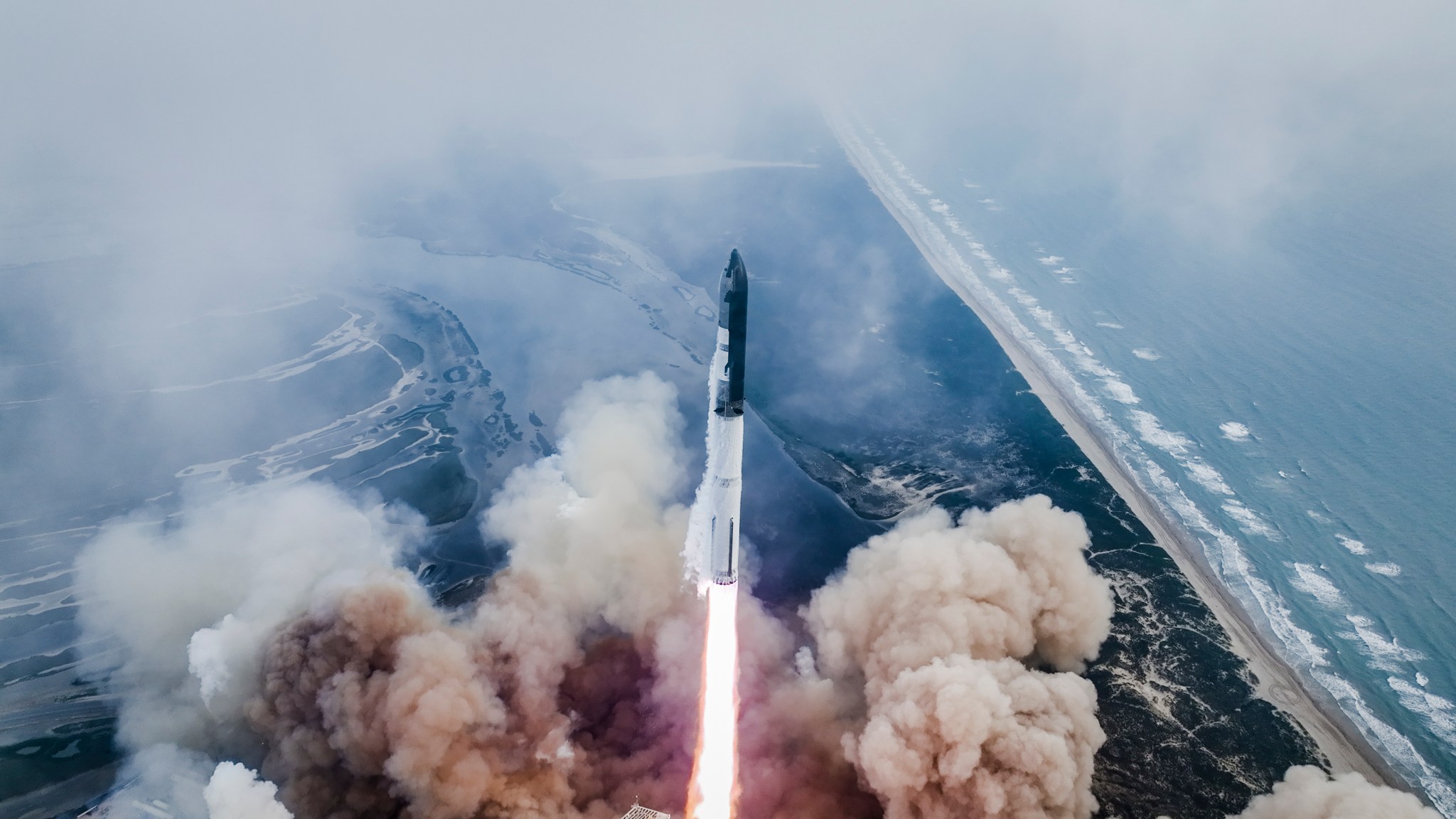
A complement of 33 Raptor engines, fueled by super-cooled liquid methane and liquid oxygen, powered the Super Heavy booster with Starship stacked on top, from the company’s Starbase orbital launch pad at 8:25 a.m. CDT. Starship, using six Raptor engines, separated from the Super Heavy booster employing a hot-staging technique to fire the engines before separation at approximately three minutes into the flight, in accordance with the flight plan. This was the third flight test of the integrated Super Heavy-Starship system.
“With each flight test, SpaceX attempts increasingly ambitious objectives for Starship to learn as much as possible for future mission systems development. The ability to test key systems and processes in flight scenarios like these integrated tests allows both NASA and SpaceX to gather crucial data needed for the continued development of Starship HLS,” said Lisa Watson-Morgan, HLS Program Manager at NASA’s Marshall Space Flight Center.
This test accomplished several important firsts that will contribute to the development of Starship for Artemis lunar landing missions. The spacecraft reached its expected orbit and Starship completed the full-duration ascent burn.
One objective closely tied to future Artemis operations is the transfer of thousands of pounds of cryogenic propellant between internal tanks during the spacecraft’s coast phase as part of NASA’s Space Technology Missions Directorate 2020 Tipping Point awards. The propellant transfer demonstration operations were completed, and the NASA-SpaceX team is currently reviewing the flight data that was received. This Tipping Point technology demonstration is one of more than 20 development activities NASA is undertaking to solve the challenges of using cryogenic fluids during future missions.
As a key step toward understanding how super-cooled propellant sloshes within the tanks when the engines shut down, and how that movement affects Starship’s stability while in orbit, engineers will study flight test data to assess the performance of thrusters that control Starship’s orientation in space. They are also interested to learn more about how the fluid’s movement within the tanks can be settled to maximize propellant transfer efficiency and ensure Raptor engines receive needed propellant conditions to support restart in orbit.
“Storing and transferring cryogenic propellant in orbit has never been attempted on this scale before,” said Jeremy Kenny, project manager, NASA’s Cryogenic Fluid Management Portfolio at Marshall. “But this is a game-changing technology that must be developed and matured for science and exploration missions at the Moon, Mars, and those that will venture even deeper into our solar system.”
Under NASA’s Artemis campaign, the agency will land the first woman, first person of color, and its first international partner astronaut on the lunar surface and prepare for human expeditions to Mars. Commercial human landing systems are critical to deep space exploration, along with the Space Launch System rocket, Orion spacecraft, advanced spacesuits and rovers, exploration ground systems, and the Gateway space station.
Read more about NASA’s Human Landing System.
Evolved Adapter for Future NASA SLS Flights Readied for Testing
A test article of the universal stage adapter for NASA’s more powerful version of its SLS (Space Launch System) rocket arrived to Building 4619 at NASA’s Marshall Space Flight Center on Feb. 22 from Leidos in Decatur, Alabama.
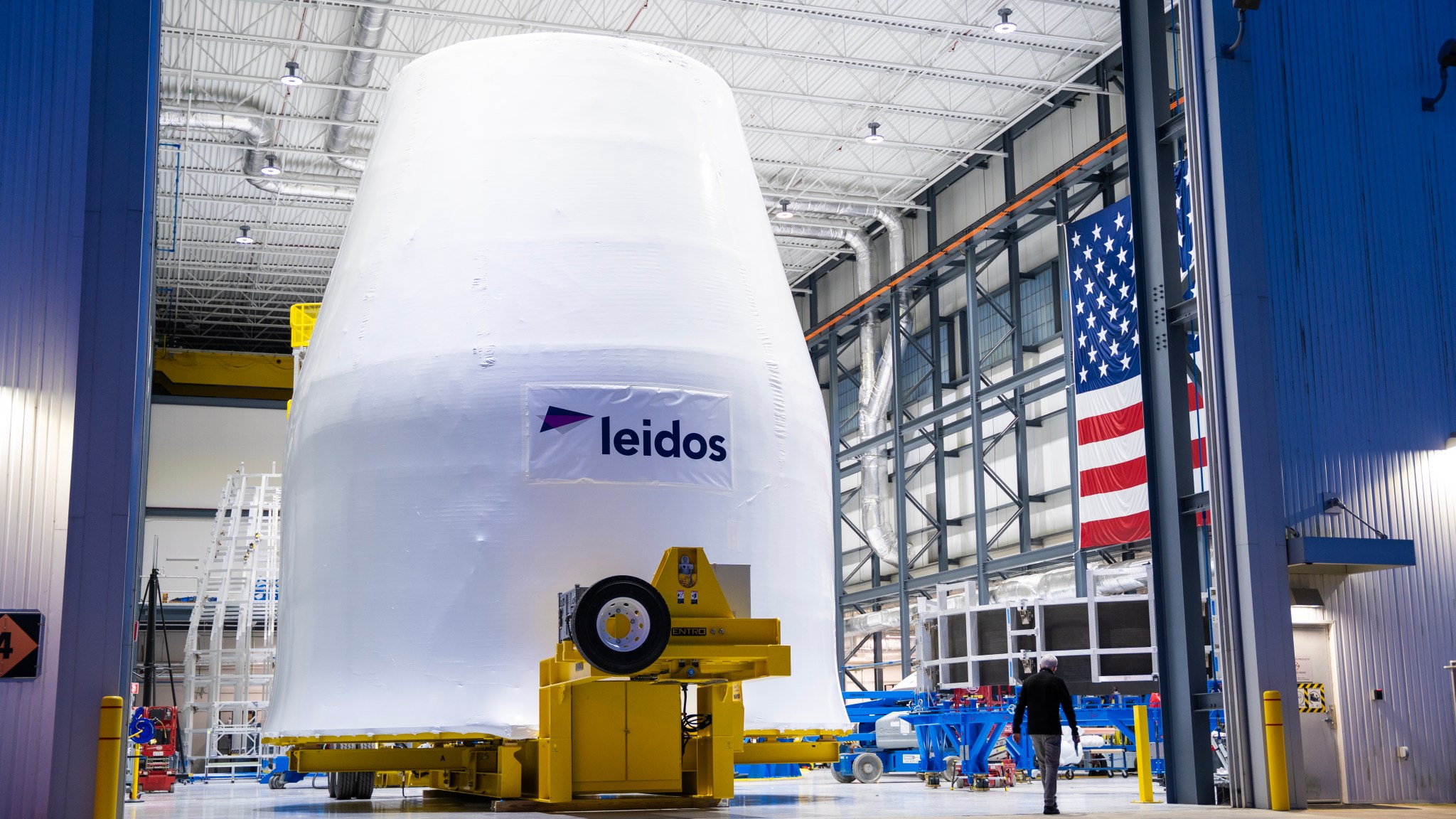
The universal stage adapter will connect the rocket’s upgraded in-space propulsion stage, called the exploration upper stage, to NASA’s Orion spacecraft as part of the evolved Block 1B configuration of the SLS rocket. It will also serve as a compartment capable of accommodating large payloads, such as modules or other exploration spacecraft. The SLS Block 1B variant will debut on Artemis IV and will increase SLS’s payload capability to send more than 84,000 pounds to the Moon in a single launch.
In Building 4619’s Load Test Annex High Bay at Marshall, the development test article will first undergo modal testing that will shake the hardware to validate dynamic models. Later, during ultimate load testing, force will be applied vertically and to the sides of the hardware. Unlike the flight hardware, the development test article has flaws intentionally included in its design, which will help engineers verify that the adapter can withstand the extreme forces it will face during launch and flight.
The test article joins an already-rich history of rocket hardware that has undergone high-and-low pressure, acoustic, and extreme temperature testing in the multipurpose, high-bay test facility; it will be tested in the same location that once bent, compressed, and torqued the core stage intertank test article for SLS rocket’s Block 1 configuration. Leidos, the prime contractor for the universal stage adapter, manufactured the full-scale prototype at its Aerospace Structures Complex in Decatur.
NASA is working to land the first woman, first person of color, and its first international partner astronaut on the Moon under Artemis. SLS is part of NASA’s backbone for deep space exploration, along with the Orion spacecraft and Gateway in orbit around the Moon and commercial human landing systems, next-generational spacesuits, and rovers on the lunar surface. SLS is the only rocket that can send Orion, astronauts, and supplies to the Moon in a single launch.
Marshall manages the SLS and human landing system programs.
NASA Study: Asteroid’s Orbit, Shape Changed After DART Impact
When NASA’s DART (Double Asteroid Redirection Test) deliberately smashed into a 560-foot-wide asteroid on Sept. 26, 2022, it made its mark in more ways than one. The demonstration showed that a kinetic impactor could deflect a hazardous asteroid should one ever be on a collision course with Earth. Now a new study published in the Planetary Science Journal shows the impact changed not only the motion of the asteroid, but also its shape.
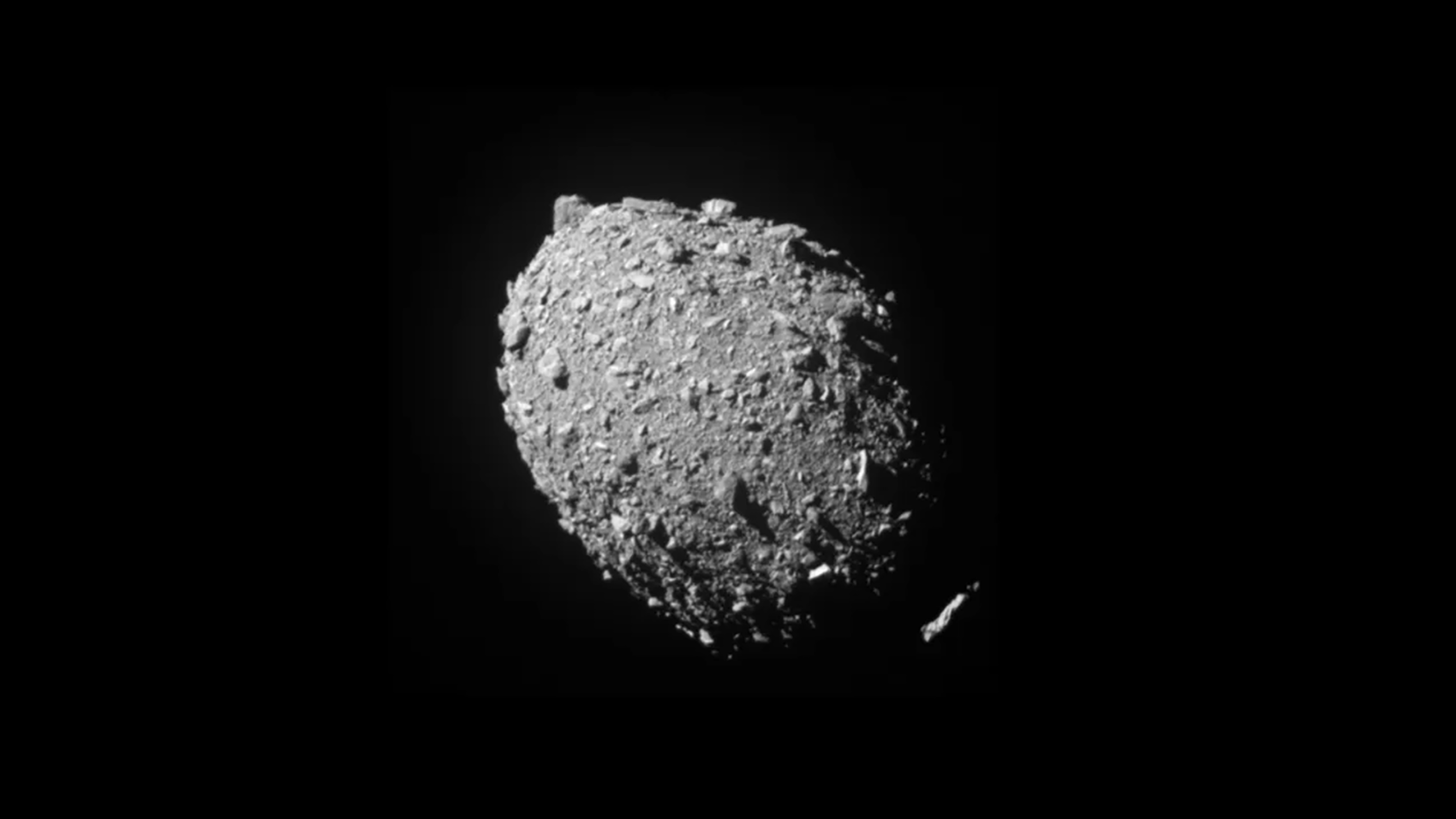
DART’s target, the asteroid Dimorphos, orbits a larger near-Earth asteroid called Didymos. Before the impact, Dimorphos had a roughly symmetrical “oblate spheroid” shape – like a squashed ball that is wider than it is tall. With a well-defined, circular orbit at a distance of about 3,900 feet from Didymos, Dimorphos took 11 hours and 55 minutes to complete one loop around Didymos.
“When DART made impact, things got very interesting,” said Shantanu Naidu, a navigation engineer at NASA’s Jet Propulsion Laboratory in Southern California, who led the study. “Dimorphos’ orbit is no longer circular: Its orbital period” – the time it takes to complete a single orbit – “is now 33 minutes and 15 seconds shorter. And the entire shape of the asteroid has changed, from a relatively symmetrical object to a ‘triaxial ellipsoid’ – something more like an oblong watermelon.”
Naidu’s team used three data sources in their computer models to deduce what had happened to the asteroid after impact. The first source was aboard DART: The spacecraft captured images as it approached the asteroid and sent them back to Earth via NASA’s Deep Space Network (DSN). These images provided close-up measurements of the gap between Didymos and Dimorphos while also gauging the dimensions of both asteroids just prior to impact.
The second data source was the DSN’s Goldstone Solar System Radar, located near Barstow, California, which bounced radio waves off both asteroids to precisely measure the position and velocity of Dimorphos relative to Didymos after impact. Radar observations quickly helped NASA conclude that DART’s effect on the asteroid greatly exceeded the minimum expectations.
The third and most significant source of data: ground telescopes around the world that measured both asteroids’ “light curve,” or how the sunlight reflecting off the asteroids’ surfaces changed over time. By comparing the light curves before and after impact, the researchers could learn how DART altered Dimorphos’ motion.
As Dimorphos orbits, it periodically passes in front of and then behind Didymos. In these so-called “mutual events,” one asteroid can cast a shadow on the other, or block our view from Earth. In either case, a temporary dimming – a dip in the light curve – will be recorded by telescopes.
See the DART impact with NASA’s Eyes on the Solar System.
“We used the timing of this precise series of light-curve dips to deduce the shape of the orbit, and because our models were so sensitive, we could also figure out the shape of the asteroid,” said Steve Chesley, a senior research scientist at JPL and study co-author. The team found Dimorphos’ orbit is now slightly elongated, or eccentric. “Before impact,” Chesley continued, “the times of the events occurred regularly, showing a circular orbit. After impact, there were very slight timing differences, showing something was askew. We never expected to get this kind of accuracy.”
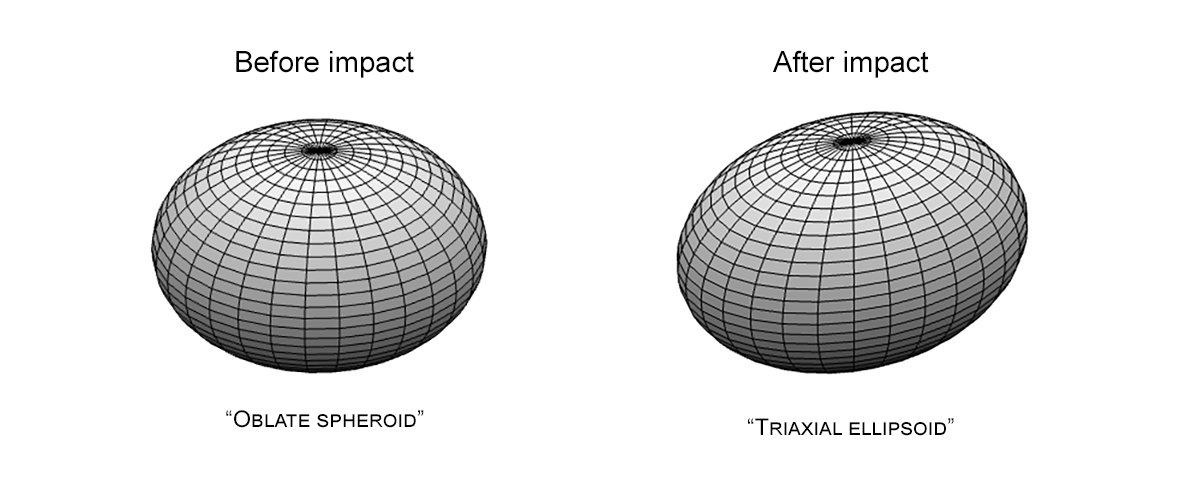
The models are so precise, they even show that Dimorphos rocks back and forth as it orbits Didymos, Naidu said.
The team’s models also calculated how Dimorphos’ orbital period evolved. Immediately after impact, DART reduced the average distance between the two asteroids, shortening Dimorphos’ orbital period by 32 minutes and 42 seconds, to 11 hours, 22 minutes, and 37 seconds.
Over the following weeks, the asteroid’s orbital period continued to shorten as Dimorphos lost more rocky material to space, finally settling at 11 hours, 22 minutes, and 3 seconds per orbit – 33 minutes and 15 seconds less time than before impact. This calculation is accurate to within 1 ½ seconds, Naidu said. Dimorphos now has a mean orbital distance from Didymos of about 3,780 feet – about 120 feet closer than before impact.
“The results of this study agree with others that are being published,” said Tom Statler, lead scientist for solar system small bodies at NASA Headquarters. “Seeing separate groups analyze the data and independently come to the same conclusions is a hallmark of a solid scientific result. DART is not only showing us the pathway to an asteroid-deflection technology, it’s revealing new fundamental understanding of what asteroids are and how they behave.”
These results and observations of the debris left after impact indicate that Dimorphos is a loosely packed “rubble pile” object, similar to asteroid Bennu. ESA’s (European Space Agency) Hera mission, planned to launch in October 2024, will travel to the asteroid pair to carry out a detailed survey and confirm how DART reshaped Dimorphos.
DART was designed, built, and operated by the Johns Hopkins Applied Physics Laboratory (APL) in Laurel, Maryland, for NASA’s Planetary Defense Coordination Office, which oversees the agency’s ongoing efforts in planetary defense. The mission is a project of the agency’s Planetary Mission Program Office, which is at NASA’s Marshall Space Flight Center. DART was humanity’s first mission to intentionally move a celestial object.
JPL, a division of Caltech in Pasadena, California, manages the DSN for NASA’s Space Communications and Navigation (SCaN) program within the Space Operations Mission Directorate at the agency’s headquarters.
Crew, Cargo Launches to Space Station Scheduled for March 21
Equipment installs, health investigations, and training occupied the schedule aboard the International Space Station on March 19 as the seven orbital residents near the arrival of three crew members and a cargo delivery.
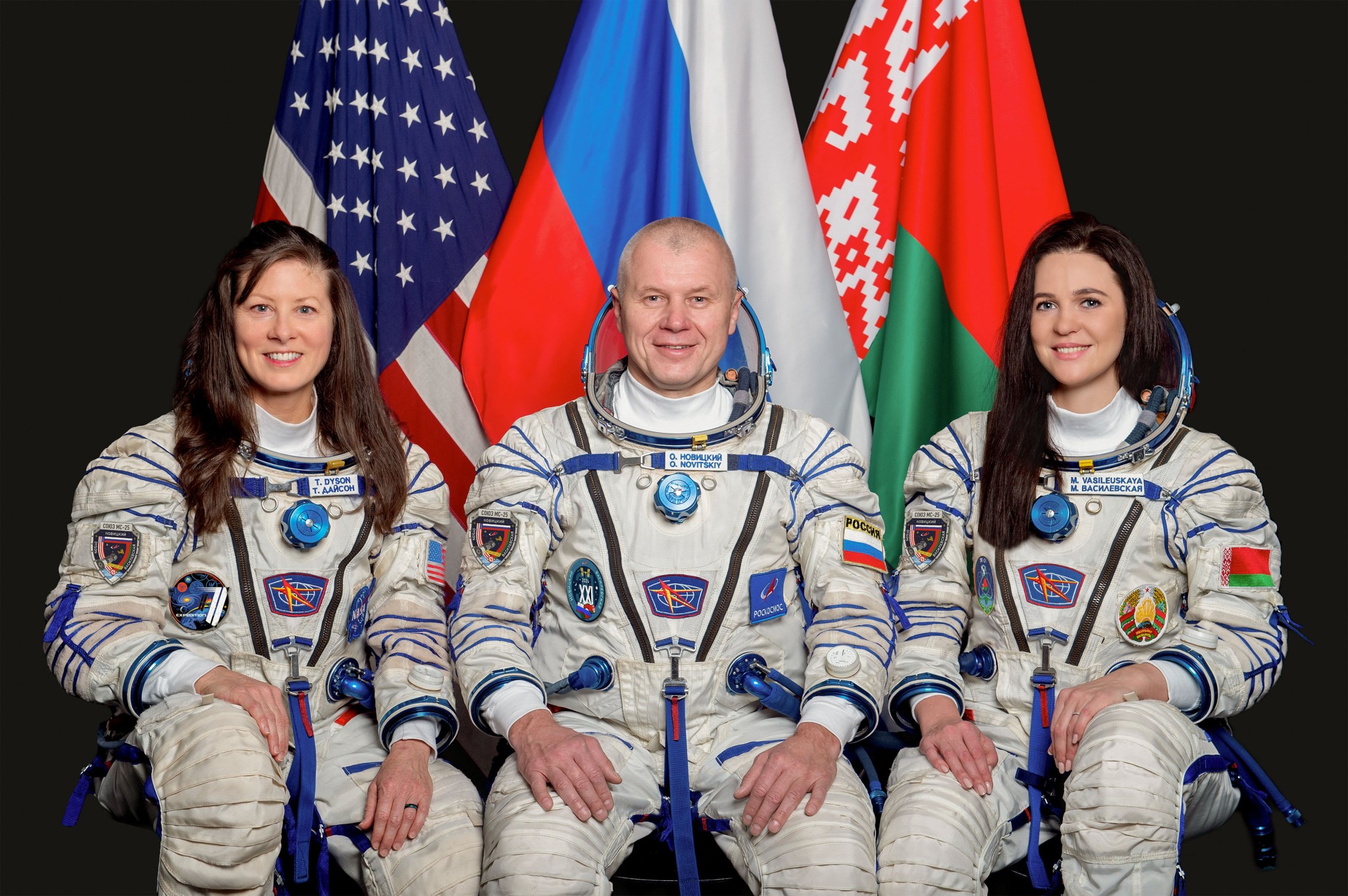
NASA’s SpaceX 30th commercial resupply mission to the station is scheduled for launch at 3:55 p.m. CDT March 21 from Space Launch Complex 40 in Florida. The Dragon cargo craft will deliver food, supplies, and new science investigations to the crew, including a set of sensors for the free-flying Astrobee robots and a new botany experiment to examine how two types of grass capture carbon dioxide from the atmosphere. Dragon will autonomously dock to the zenith port of the Harmony module at 6:30 a.m. March 23.
Ahead of Dragon’s liftoff, three crew members – NASA astronaut Tracy Dyson, cosmonaut Oleg Novitsky, and Flight Engineer Marina Vasilevskaya of Belarus – will launch from the Baikonur Cosmodrome in Kazakhstan at 8:21 a.m. March 21. The international crew will take a short ride to the station, docking only a few hours later at 11:39 p.m., before opening the hatch and joining the Expedition 70 crew in microgravity. Dyson will begin a six-month microgravity research mission once aboard, while Novitsky and Vasilevskaya will spend 12 days on station before departing back to Earth with NASA astronaut Loral O’Hara.
NASA TV will cover both launches beginning at 7:20 a.m. and 3:35 p.m. respectively.
Aboard station, the crew returned to work March 19 following a few days off-duty. Throughout the day, O’Hara and two of her NASA crewmates, Michael Barratt and Matthew Dominick, completed a round of SpaceX Dragon rendezvous training ahead of Dragon’s cargo arrival.
The HOSC (Huntsville Operations Support Center) at NASA’s Marshall Space Flight Center provides engineering and mission operations support for the space station, the Commercial Crew Program, and Artemis missions, as well as science and technology demonstration missions. The Payload Operations Integration Center within the HOSC operates, plans, and coordinates the science experiments onboard the space station 365 days a year, 24 hours a day.
Europa Clipper Mission Highlighted on ‘This Week at NASA’
Technicians at NASA’s Kennedy Space Center recently fully extended the first of two five-panel solar arrays for the agency’s Europa Clipper spacecraft. The mission is featured in “This Week @ NASA,” a weekly video program broadcast on NASA-TV and posted online.
The 46.5-foot arrays also will be inspected and cleaned as part of assembly, test, and launch operations. Targeted for launch in October 2024, the mission will study Jupiter’s moon Europa, which is believed to have a global ocean beneath its icy crust that has more water than all of Earth’s oceans combined.
Managed by Caltech in Pasadena, California, JPL leads the development of the Europa Clipper mission in partnership with the Johns Hopkins Applied Physics Laboratory (APL) in Laurel, Maryland, for NASA’s Science Mission Directorate. APL designed the main spacecraft body in collaboration with JPL and NASA’s Goddard Space Flight Center. The Planetary Missions Program Office at NASA’s Marshall Space Flight Center executes program management of the Europa Clipper mission.
View this and previous episodes at “This Week @NASA” on NASA’s YouTube page.
What's Your Reaction?



















.jpg?#)


























